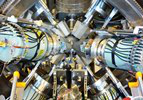Peter-R. Kettle
(Paul Scherrer Institut)
21/10/2016, 13:45
Invited
The intensity frontier has, in addition to technological developments, enabled a boom in muon physics allowing both mu- & mu+ beams to set some of the most stringent limits on fundamental parameters and decays, also reflected in the increased demand for muonic atom spectroscopy experiments.
A general overview of muon beam production techniques and possibilities offered by PSI's High Intensity...
Prof.
Peter Reiter
(University of Cologne)
21/10/2016, 14:15
Invited
The high-resolution MINIBALL germanium detector array consists of 24 six-fold segmented, tapered, encapsulated high-purity germanium crystals. It was specially designed for low multiplicity experiments with low-intensity radioactive ion beams (RIB). Main features of the spectrometer are a very high photo peak efficiency for gamma or X-ray radiation and position sensitivity due to the...
Prof.
Maxim Pospelov
(Perimeter Institute for theoretical physics)
21/10/2016, 14:45
Invited
I will describe several conceptual schemes for detecting parity violating muon-nucleus interactions.
1. Muonic atoms, where Z=30 and higher atoms offer a possibility to look for 2S->1S parity violating transition.
2. Scattering of polarized muons, where muon spin is manipulated in a storage-ring type set-up.
3. Using optical activity type rotation of the transverse linear polarization of muons.
Dr
Leopold Simons
(Paul Scherrer Institute)
21/10/2016, 15:40
Invited
Muonic atoms had been considered around 1974 as candidates for experiments to study neutral weak currents. Two main directions had been followed: M1(E1) mixing in s-p states and E2(E1) mixing in p-d states. After an introduction into the subject which outlines the special role of muonic atoms, the implications of the two approaches are discussed. In the M1(E1) mixing the influence of the...
Prof.
Klaus Jungmann
(University of Groningen)
21/10/2016, 16:10
Invited
The observation Atomic Parity Violation in atoms has been crucial for the acceptance of the Standard Model as a general theory in physics. Today APV has been measured best in Cs atoms and provides for precise value of the weak mixing (Weinberg) angle at the lowest energies with sub % accuracy. A deviation of this value from predictions based on measurements in all accessible ranges of momentum...
Dr
Frederik Wauters
(Johannes Gutenberg University Mainz)
21/10/2016, 16:40
Invited
Searching for neutral current effects in muonic atoms is an old idea. A muon around a nucleus in the 2S state gets a small parity violating admixture from the 2P state, which then allows E1-M1 interference in the 2S-1S. For nuclei around Z=30, the experimental challenge is to deal with the intense background from nP-1S transitions and electrons from Michel decays. We investigate the...

